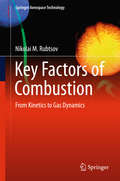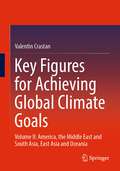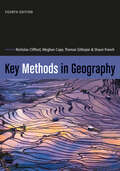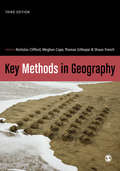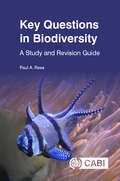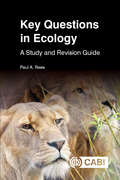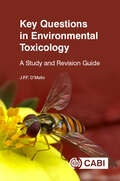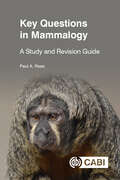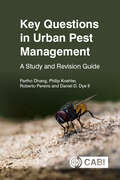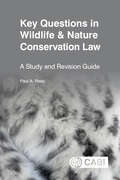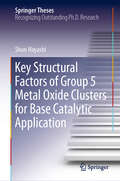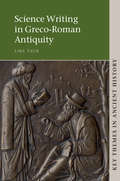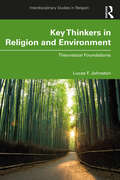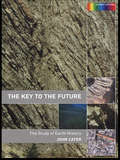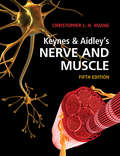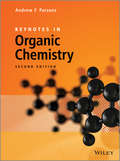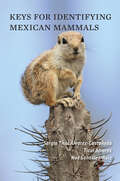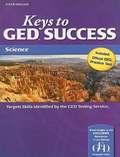- Table View
- List View
Key Factors of Combustion
by Nikolai M. RubtsovThis book summarizes the main advances in the mechanisms of combustion processes. It focuses on the analysis of kinetic mechanisms of gas combustion processes and experimental investigation into the interrelation of kinetics and gas dynamics in gas combustion. The book is complimentary to the one previously published, The Modes of Gaseous Combustion.
Key Figures for Achieving Global Climate Goals: Volume II: America, the Middle East and South Asia, East Asia and Oceania
by Valentin CrastanThis volume analyses the energy industry for the following geographical units: America – divided into North America (Canada + USA) and Central and South America –, the Middle East and South Asia, East Asia and Oceania. The key energy-economic indicators for each region and country and their development, are illustrated in numerous graphs and energy flow diagrams. Based on this analysis, the author recommends a distribution of emission reductions necessary to limit climate change (for the 2°C and 1.5°C climate goals, with a perspective up to 2050).The continents covered in this volume collectively account for 77% of emissions. Europe + Eurasia and Africa will be addressed in volume I.
Key Methods in Geography
by Gill Valentine Nicholas Clifford Shaun FrenchNow in a new edition, Key Methods in Geography is an introduction to the principal methodological issues involved in the collection, analysis and presentation of geographical information. It is unique in the reference literature for providing an overview of qualitative and quantitative methods for human and physical geography. An accessible primer, it will be used by students as a reference throughout their degree, on all issues from research design to presentation. This new edition has been fully revised and updated and includes new chapters on internet mediated research, diaries as a research method, making observations and measurements in the field, and the analysis of natural systems. Organized into four sections: getting started in geographical research; generating and working with data in human geography; generating and working with data in physical geography; representing and interpreting geographical data; each chapter comprises: • a short definition • a summary of the principal arguments • a substantive 5,000-word discussion • use of real-life examples • annotated notes for further reading. The teaching of research methods is integral to all geography courses: Key Methods in Geography, 2nd Edition explains all of the key methods with which geography undergraduates must be conversant.
Key Methods in Geography
by Nicholas Clifford Meghan Cope Thomas GillespieKey Methods in Geography is the perfect introductory companion, providing an overview of qualitative and quantitative methods for human and physical geography. The fourth edition of this essential and accessible primer covers the breadth of the discipline and offer critical and contextual perspectives on research methods. New coverage takes account of newer technologies and practice, and 9 new chapters bring greater diversity of positionality and perspective to the volume, including decolonial methods, predicting, visualizing and modelling climate and environmental change, and writing up research. Case study examples, summaries and exercises have been included in each chapter to enable learning. This is vital reading for any student undertaking a Geography Methods module as well as a valuable resource for any student embarking on independent research as part of their degree.
Key Methods in Geography
by Nicholas Clifford Meghan Cope Thomas GillespieKey Methods in Geography is the perfect introductory companion, providing an overview of qualitative and quantitative methods for human and physical geography. The fourth edition of this essential and accessible primer covers the breadth of the discipline and offer critical and contextual perspectives on research methods. New coverage takes account of newer technologies and practice, and 9 new chapters bring greater diversity of positionality and perspective to the volume, including decolonial methods, predicting, visualizing and modelling climate and environmental change, and writing up research. Case study examples, summaries and exercises have been included in each chapter to enable learning. This is vital reading for any student undertaking a Geography Methods module as well as a valuable resource for any student embarking on independent research as part of their degree.
Key Methods in Geography
by Nicholas Clifford Shaun French Professor Meghan Cope Thomas W. Gillespie"Practical, accessible, careful and interesting, this...revised volume brings the subject up-to-date and explains, in bite sized chunks, the 'how's' and 'why's' of modern day geographical study...[It] brings together physical and human approaches again in a new synthesis." —Danny Dorling, Professor of Geography, University of Oxford Key Methods in Geography is the perfect introductory companion, providing an overview of qualitative and quantitative methods for human and physical geography. This Third Edition Features: 12 new chapters representing emerging themes including online, virtual and digital geographical methods Real-life case study examples Summaries and exercises for each chapter Free online access to full text of Progress in Human Geography and Progress in Physical Geography Progress Reports The teaching of research methods is integral to all geography courses: Key Methods in Geography, Third Edition explains all of the key methods with which geography undergraduates must be conversant.
Key Methods in Geography
by Nicholas Clifford Shaun French Professor Meghan Cope Thomas W. Gillespie"Practical, accessible, careful and interesting, this...revised volume brings the subject up-to-date and explains, in bite sized chunks, the "how's" and "why's" of modern day geographical study...[It] brings together physical and human approaches again in a new synthesis." - Danny Dorling, Professor of Geography, University of Oxford Key Methods in Geography is the perfect introductory companion, providing an overview of qualitative and quantitative methods for human and physical geography. New to the third edition: 12 new chapters representing emerging themes including online, virtual and digital geographical methods Video introductions for each section Real-life case study examples Summaries and exercises for each chapter Free online access to full text of Progress in Human Geography and Progress in Physical Geography Progress Reports The teaching of research methods is integral to all geography courses: Key Methods in Geography, 3rd Edition explains all of the key methods with which geography undergraduates must be conversant.
Key Questions in Animal Behaviour and Welfare: A Study and Revision Guide (Key Questions)
by Dr Paul ReesAn understanding of animal behaviour and welfare is an important requirement of a wide range of programmes of study including biology, zoology, animal welfare, animal behaviour, psychology and zoo biology. This book is intended as a study and revision guide for students following programmes of study in which animal behaviour and welfare are an important component. It contains 600 multiple-choice questions (and answers) set at three levels - foundation, intermediate and advanced - and grouped into 10 major topic areas: 1. Foundations and history of animal behaviour and welfare 2. Basic concepts and mechanisms in behaviour 3. Biological basis of behaviour 4. Learning, memory and training 5. Territoriality, navigation and migration 6 Animal cognition and communication 7. Behavioural ecology and social behaviour 8. Measuring, recording and analysing animal behaviour and welfare 9. Animal exploitation and welfare 10 Animal rights, ethics and law The book has been produced in a convenient format so that it can be used at any time in any place. It allows the reader to learn and revise the meaning of terms used in the study of animal behaviour and welfare, methods of recording behaviour and assessing welfare, the physiology of behaviour, learning, memory, cognition, behavioural ecology, animal rights and much more. Many of the questions require students to use their knowledge to interpret information provided in the form of graphs, data or photographs.
Key Questions in Applied Ecology and Conservation: A Study and Revision Guide (Key Questions)
by Dr Paul ReesAn understanding of applied ecology and conservation is an important requirement of a wide range of programmes of study including applied biology, ecology, environmental science and wildlife conservation. This book is a study and revision guide for students following such programmes. It contains 600 multiple-choice questions (and answers) set at three levels - foundation, intermediate and advanced - and grouped into 10 major topic areas: History and foundations of applied ecology and conservation Environmental pollution and perturbations Wildlife and conservation biology Restoration biology and habitat management Agriculture, forestry and fisheries management Pest, weed and disease management Urban ecology and waste management Global environmental change Environmental and wildlife law and policy Environmental assessment, monitoring and modelling The book has been produced in a convenient format so that it can be used at any time in any place. It allows the reader to learn and revise the meaning of terms used in applied ecology and conservation, study the effects of pollution on ecosystems, the management, conservation and restoration of wildlife populations and habitats, urban ecology, global environmental change, environment law and much more. The structure of the book allows the study of one topic area at a time, progressing through simple questions to those that are more demanding. Many of the questions require students to use their knowledge to interpret information provided in the form of graphs, data or photographs.
Key Questions in Biodiversity: A Study and Revision Guide (Key Questions)
by Dr Paul ReesAn understanding of biodiversity is an important requirement of a wide range of programmes of study including biology, zoology, wildlife conservation and environmental science. This book is a study and revision guide for students following such programmes in which biodiversity is an important component. It contains 600 multiple-choice questions (and answers) set at three levels - foundation, intermediate and advanced - and grouped into 10 major topic areas: 1. Principles of classification and taxonomy 2. Comparative anatomy and physiology 3. Protoctists, monerans, fungi, lichens and acellular organisms 4. 'Lower' plants and pteridophytes 5. Seed-bearing plants 6. Sponges, cnidarians, nematodes and minor animal phyla 7. Platyhelminths, annelids and molluscs 8. Arthropods and echinoderms 9. Fishes, amphibians and reptiles 10. Birds and mammals The book has been produced in a convenient format so that it can be used at any time in any place. It allows the reader to learn and revise the meaning of terms used in animal and plant classification, the principles of comparative physiology, and the characteristics of, and diversity in, the major animal and plant taxa. The structure of the book allows the study of one topic area or group of taxa at a time, progressing through simple questions to those that are more demanding. Many of the questions require students to use their knowledge to identify organisms and biological structures from drawings or photographs.
Key Questions in Ecology: A Study and Revision Guide (Key Questions)
by Dr Paul ReesAn understanding of ecology is an important requirement of a wide range of academic areas, including biology, zoology and environmental science. This book is a study and revision guide for students following programmes of study in which ecology is an important component. It contains 600 multiple-choice questions (and answers) set at three levels - foundation, intermediate and advanced - and grouped into 10 major topic areas: · The history and foundations of ecology · Abiotic factors and environmental monitoring · Taxonomy and biodiversity · Energy flow and production ecology · Nutrient and material cycles · Ecophysiology · Population ecology · Community ecology and species interactions · Ecological genetics and evolution · Ecological methods and statistics The book has been produced in a convenient format so that it can be used at any time in any place. It allows the reader to learn and revise the meaning of ecological terms, the basic processes operating in ecosystems, the dynamics of populations, ecological genetics and the process of evolution, the methods used in ecological surveys, and much more. The structure of the book allows the study of one topic area at a time, progressing through simple questions to those that are more demanding. Many of the questions require students to use their knowledge to interpret information provided in the form of graphs, data or photographs, providing a useful tool for independent study.
Key Questions in Environmental Toxicology: A Study and Revision Guide (Key Questions)
by J P D'MelloKey Questions in Environmental Toxicology is designed as a self-study tool for undergraduate students. Questions review the origin, characterization and environmental distribution of major pollutants, followed by their absorption and metabolic disposition in living organisms. They address implications for the development of cancer, cardiovascular disease, pulmonary dysfunction and neurological conditions in relation to gaseous pollutants, particulates, persistent organic compounds and radioactive emissions, then cover the impact of pollutants on biodiversity, food safety, and water contamination. This book: - Covers toxicology from human morbidity, ecological impact and biodiversity perspectives, and emphasises the impact of diverse organic pollutants in worsening these interconnected phenomena, leading to wider environmental emergencies; - Provides a selection of fill-in-the-gap, multiple choice and short answer question types for students to vary their learning and enhance motivation; - Includes full answer rationales, allowing students to gain true insight into the subject. Providing support to programmes across environmental science, ecology and human health, and covering all the major biological toxins and pollutants as well as unintended consequences of actions designed to improve outcomes, this book may be used in conjunction with the companion volume Introduction to Environmental Toxicology.
Key Questions in Mammalogy: A Study and Revision Guide (Key Questions)
by Dr Paul ReesAlthough mammals comprise a relatively small proportion of total biodiversity they are disproportionately represented in courses in biology and zoology and they are the dominant taxon in zoos around the world. Mammalogy is well-established as a discrete element of biological courses in some parts of the world, notably in North America. This book is intended as a study and revision guide for students following programmes of study in which mammalogy is an important component. It comprises 600 multiple-choice questions (and answers) set at three levels - foundation, intermediate and advanced - grouped into 10 major topic areas: 1. The history and principles of mammalogy 2. Origins, evolution and taxonomy 3. Anatomy 4. Physiology 5. Behaviour 6 Ecology and genetics 7. Zoogeography 8. Conservation and management 9. Parasites and diseases 10. Domestication and human use of animals The book is designed to be used at any time in any place. It allows the reader to study the meaning of terms used in mammalogy, the history of mammalogy, the taxonomy, evolution and genetics of mammals, their zoogeography, their anatomy, physiology and adaptations to their environment, their behaviour, their conservation and management, their diseases, and their domestication and use by humans. Some of the questions will require students to use their knowledge to interpret information provided in the form of graphs, data, maps or photographs
Key Questions in Urban Pest Management: A Study and Revision Guide (Key Questions)
by Partho Dhang Roberto Pereira Philip Koehler Dr Daniel Dye IIUrban pests are common all over the world. These include cockroaches, flies, mosquitoes, bed bugs, ticks, fleas, ants, termites, rodents and others. These pests thrive in human structures, where there is food, warmth and places to hide. Urban pests are one of the leading causes of illnesses in humans due to allergies, bites, food contamination and phobias. They can also cause significant damage to property and structures. Knowledge and training in this field is vital for professional and trainee pest managers. This book is specifically intended to provide an aid to such candidates. The book contains 500 multiple-choice questions (and answers) grouped into the following major topic areas: · The history of urban entomology · Household pests · Cockroaches · Flies · Mosquitoes · Bed bugs · Termites · Sporadic pests · Stored product pests · Vertebrate pests · Pesticides and pesticide formulations · Handling pesticides · Integrated Pest Control Produced in a convenient format that can be used at any time in any place, the book allows the reader to learn and revise the subject and much more. Its structure allows the study of one topic area at a time, progressing through a simple introduction followed by key revision questions, many of which require students to use their practical knowledge. The answers to each of the questions are provided at the end with short explanations wherever appropriate.
Key Questions in Wildlife & Nature Conservation Law: A study and revision guide (Key Questions)
by Dr Paul ReesLaw plays an essential part in the conservation of wildlife and ecosystems. The study of wildlife and nature conservation law is an important component of a wide range of programmes of study including wildlife conservation, environmental management and environmental law. This book is a study and revision guide for students following such programmes. It contains 600 multiple choice questions (and answers) set at three levels - foundation, intermediate and advanced - and grouped into 10 major topic areas: 1. Principles of Wildlife and Nature Conservation Law 2. History of Wildlife and Nature Conservation Law 3. Species Protection and Exploitation I - EU and International Law 4. Species Protection and Exploitation II - National Laws 5. Protected Areas and Habitats I - EU and International Laws 6. Protected Areas and Habitats II - National Laws 7. Planning, Pollution, Restoration and Conservation Funding 8. Wildlife Trade, Animal Collections and Alien Species 9. Wildlife Law Enforcement and Penalties 10. Legal Texts This book has been produced in a convenient format so that it can be used at any time, in any place. It allows the reader to learn and revise the meaning of terms used in wildlife and nature conservation law and study the role of legislation at national, European Union (EU) and international level in the protection of individual species, habitats and landscapes. It uses examples from a wide variety of taxa, habitats and protected areas selected from a range of jurisdictions from the United Kingdom, the United States and Australia to Antarctica and the High Seas. Topics include the control of hunting, the conservation of trees and forests, the protection of National Parks and wilderness areas, wildlife trade and the organisations involved in the enforcement of wildlife laws. The structure of the book allows the study of one topic area at a time, progressing through simple questions to those that are more demanding. Some of the questions require students to use their knowledge to interpret information provided in the form of photographs and legal texts.
Key Questions in Zoo and Aquarium Studies: A Study and Revision Guide (Key Questions)
by Dr Paul ReesAn understanding of the work of zoos and aquariums is central to many programmes of study in wildlife conservation and more specialised programmes in zoo and aquarium science and management. This book is intended as a study and revision guide for students following these programmes. It contains 600 multiple-choice questions (and answers) set at three levels - foundation, intermediate and advanced - and grouped into 10 major topic areas: 1. History of zoos and aquariums 2. Zoo and exhibit design 3. Aquariums and Aquatic exhibits 4 Visitor studies, zoo education and zoo research 5. Nutrition and food presentation 6 Reproductive biology and genetics 7. Conservation breeding and assisted reproductive technologies 8. Behaviour, training and environmental enrichment 9. Animal welfare and conservation medicine 10. Zoo organisation and regulation The book has been produced in a convenient format so that it can be used at any time in any place. It allows the reader to learn and revise the meaning of terms used in zoo and aquarium biology, the principles of animal husbandry and enclosure design, the behaviour of zoo visitors, the operation of captive breeding programmes, the international organisation of zoos, their legal regulation and much more. The structure of the book allows the study of one topic area at a time, progressing through simple questions to those that are more demanding. Many of the questions require students to use their knowledge to interpret information provided in the form of graphs, diagrams, data or photographs.
Key Structural Factors of Group 5 Metal Oxide Clusters for Base Catalytic Application (Springer Theses)
by Shun HayashiThis book provides detailed information on the base catalysis of group 5 (Nb, Ta) metal oxide clusters by elucidating how the structural factors such as constituent metals, counter cations, and local structures of base sites affect their catalysis. Uniquely, it reveals the effects of key structural factors at the molecular level by combining experimental and theoretical approaches. The findings presented here provide rational design principles for base catalysis and will foster the development of promising catalysts for solving current and future energy and environmental problems.
Key Themes in Ancient History: Science Writing in Greco-Roman Antiquity
by Liba TaubWe access Greek and Roman scientific ideas mainly through those texts which happen to survive. By concentrating only on the ideas conveyed, we may limit our understanding of the meaning of those ideas in their historical context. Through considering the diverse ways in which scientific ideas were communicated, in different types of texts, we can uncover otherwise hidden meanings and more fully comprehend the historical contexts in which those ideas were produced and shared, the aims of the authors and the expectations of ancient readers. Liba Taub explores the rich variety of formats used to discuss scientific, mathematical and technical subjects, from c. 700 BCE to the sixth century CE. Each chapter concentrates on a particular genre - poetry, letter, encyclopaedia, commentary and biography - offering an introduction to Greek and Roman scientific ideas, while using a selection of ancient writings to focus on the ways in which we encounter them.
Key Thinkers in Religion and Environment: Theoretical Foundations (Interdisciplinary Studies in Religion)
by Lucas F. JohnstonKey Thinkers in Religion and Environment provides a theoretical foundation for scholarship related to the intersection of religions, natures and cultures across disciplines.The text introduces students to the major names, theoretical issues, and methodological orientations of the field while giving professors maximum freedom to insert case studies and examples as they wish. Students will come away with an understanding of the most important scholars, their theoretical contributions, and the scholarly conundrums with which they wrestled. The book includes figures who are foundational to the field of religious studies more broadly, foregrounding key themes in their works which highlight the “nature” in/of their argumentation, whilst also highlighting the voices of women and people of color. The thinkers come from a range of fields, including religious studies, philosophy, anthropology, sociology, American Indian studies, ethology, agroecology, theology, and environmental history, demonstrating the importance and impact of interdisciplinary research. The book also offers a theoretical orientation which illuminates methodological and theoretical deficits in religious studies more generally, whilst opening new avenues for thinking about environmental ethics.It is a must-read for all students and researchers of religion and the environment.
Key Topics in Conservation Biology 2
by David W. MacdonaldFollowing the much acclaimed success of the first volume of Key Topics in Conservation Biology, this entirely new second volume addresses an innovative array of key topics in contemporary conservation biology. Written by an internationally renowned team of authors, Key Topics in Conservation Biology 2 adds to the still topical foundations laid in the first volume (published in 2007) by exploring a further 25 cutting-edge issues in modern biodiversity conservation, including controversial subjects such as setting conservation priorities, balancing the focus on species and ecosystems, and financial mechanisms to value biodiversity and pay for its conservation. Other chapters, setting the framework for conservation, address the sociology and philosophy of peoples’ relation with Nature and its impact on health, and such challenging practical issues as wildlife trade and conflict between people and carnivores. As a new development, this second volume of Key Topics includes chapters on major ecosystems, such as forests, islands and both fresh and marine waters, along with case studies of the conservation of major taxa: plants, butterflies, birds and mammals. A further selection of topics consider how to safeguard the future through monitoring, reserve planning, corridors and connectivity, together with approaches to reintroduction and re-wilding, along with managing wildlife disease. A final chapter, by the editors, synthesises thinking on the relationship between biodiversity conservation and human development. Each topic is explored by a team of top international experts, assembled to bring their own cross-cutting knowledge to a penetrating synthesis of the issues from both theoretical and practical perspectives. The interdisciplinary nature of biodiversity conservation is reflected throughout the book. Each essay examines the fundamental principles of the topic, the methodologies involved and, crucially, the human dimension. In this way, Key Topics in Conservation Biology 2, like its sister volume, Key Topics in Conservation Biology, embraces issues from cutting-edge ecological science to policy, environmental economics, governance, ethics, and the practical issues of implementation. Key Topics in Conservation Biology 2 will, like its sister volume, be a valuable resource in universities and colleges, government departments, and conservation agencies. It is aimed particularly at senior undergraduate and graduate students in conservation biology and wildlife management and wider ecological and environmental subjects, and those taking Masters degrees in any field relevant to conservation and the environment. Conservation practitioners, policy-makers, and the wider general public eager to understand more about important environmental issues will also find this book invaluable.
Key to The Future: The History of Earth Science
by John CaterHere is a book for everyone who has an interest in how our planet works, what has happened during its 4,550 million year history and what might happen in the future. It tells how Earth scientists study the pattern of events that have shaped the planet and guided the evolution of life on Earth. In clear and simple language it describes how the effec
Keynes & Aidley's Nerve and Muscle
by Christopher L.-H. HuangThis well-established and acclaimed textbook introducing the rapidly growing field of nerve and muscle function has been completely revised and updated. Written with undergraduate students in mind, it begins with the fundamental principles demonstrated by the pioneering electrophysiological experiments on cell excitability. This leads to more challenging material recounting recent discoveries from applying modern biochemical, genetic, physiological and biophysical, experimental and mathematical analysis. The resulting interdisciplinary approach conveys a unified contemporary understanding of nerve and skeletal, cardiac and smooth muscle function at the molecular, cellular and systems levels. Emphasis on important strategic experiments throughout clarifies the basis for our current scientific views, highlights the excitement and challenge of biomedical discovery, and suggests directions for future advances. These fundamental ideas are then translated into discussions of related disease conditions and their clinical management. Now including colour illustrations, it is an invaluable text for students of physiology, neuroscience, cell biology and biophysics.
Keynotes in Organic Chemistry
by Andrew F. ParsonsThis concise and accessible book provides organic chemistry notes for students studying chemistry and related courses at undergraduate level, covering core organic chemistry in a format ideal for learning and rapid revision. The material is organised so that fundamental concepts are introduced early, then built on to provide an overview of the essentials of functional group chemistry and reactivity, leading the student to a solid understanding of the basics of organic chemistry. Graphical presentation of information is central to the book, to facilitate the rapid assimilation, understanding and recall of critical concepts, facts and definitions.Students wanting a comprehensive and accessible overview of organic chemistry to build the necessary foundations for a more detailed study will find this book an ideal source of the information they require. In addition, the structured presentation, highly graphical nature of the text and practice problems with outline answers will provide an invaluable framework and aid to revision for students preparing for examinations. Keynotes in Organic Chemistry is also a handy desk reference for advanced students, postgraduates and researchers.For this second edition the text has been completely revised and updated. Colour has been introduced to clarify aspects of reaction mechanisms, and new margin notes to emphasise the links between different topics. The number of problems have been doubled to approximately 100, and includes spectra interpretation problems. Each chapter now starts with diagrams to illustrate the key points, and ends with a list of key reactions and a worked example.
Keys for Identifying Mexican Mammals
by Sergio Ticul Álvarez-Castañeda Ticul Álvarez Noé González-RuizFully updated and revised, this is the bestselling comprehensive bilingual identification guide to Mexico’s diverse mammalian fauna.A remarkable achievement that took over 30 years to construct, Keys for Identifying Mexican Mammals is the only complete identification guide to Mexico’s mammalian fauna. Fully updated and revised, this bestselling book follows a bilingual arrangement, with identical information presented in Spanish and English on facing pages. The dichotomous presentation is both easy to follow and flawlessly compiled, including updated and expanded material that surpasses any previously available resource. Hundreds of diagnostic images are dispersed throughout the book, many showing minute details that differentiate one species from another, and introductory materials carefully explain the use of diagnostic features. The heart of the book, though, is the keys themselves, which cover every taxa—from artiodactyls and carnivores to primates and rodents—while allowing confident identification at the species level for both field and museum use. The book closes with appendices that cover preparation of specimens, a glossary, and a bibliography. Anyone with an interest in the mammalian fauna of Mexico, or mammals in general, will find this one-of-a-kind book an indispensable reference to Mexico’s rich diversity of wildlife.
Keys to GED Success: Science
by Steck-VaughnThis book focuses on the thinking and graphic interpretation skills needed to pass the GED Science Test.
